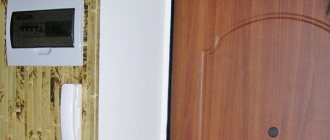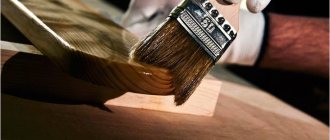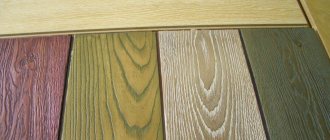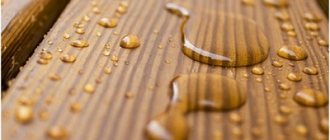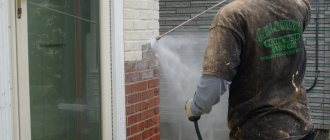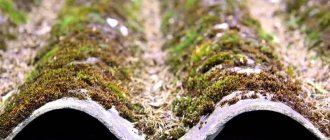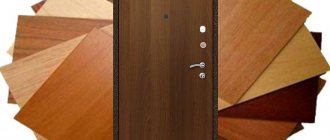How to paint a wooden street door: choosing paint
The ecology of your home will be at risk if the wood paint you choose contains petroleum products. The most toxic of them are toluene and xylene. These aromatic hydrocarbons should not be present in the paint. Therefore, carefully study the composition of the paint on the packaging.
- Nitroenamel is a nitro paint on wood that emits a suffocating odor. This paint is applied quite easily with a brush and dries quickly, in just one hour. But to be completely honest, such a coating is not very functional. When applying nitro enamel, the solvent evaporates. The result is a coating that practically does not stick to anything: neither acetone nor water. Plus poor stain resistance.
- Alkyd enamels are traditionally popular among consumers. They are superior to all organic solvent based paints in terms of abrasion and durability. By carefully preparing the coating surface and following the paint application technology, you can achieve excellent results: a beautiful glossy surface. However, alkyd enamels also have disadvantages. They can be called paints for those who are patient: they dry from 12 to 24 hours.
- Acrylic water-dispersion paints are water emulsions, one of the most optimal options for painting wood. They dry well and have no smell. They are easily applied to the surface, have good adhesion and form a perfectly even coating. Acrylic paints are durable and resistant: filling the smallest cracks they can form a durable surface.
If you want to live in an environmentally friendly home, choose paints that contain foundationicides and biocides. These are environmentally friendly compounds that can protect wooden surfaces from mold and fungi.
Choosing a varnish to coat a wooden door, the specifics of applying glue to the surface
If the method of painting a wooden door does not suit you, or you want to cover not an old door, but a new one, but without finishing, then varnish is best suited to maintain the natural texture and shade of wood. But you need to choose the right varnish, because each surface has its own composition.
Varnish and any other product applied simultaneously to the canvas must have the same properties.
The assortment of varnish can confuse an uninformed person. Some formulations have a very strong odor, others are barely noticeable. There are several types of varnish:
- Nitrovarnish - similar in composition to the first option. Dries quickly. For even application it is better to use a paint sprayer.
- Polyurethane varnish is the most resistant to external influences and lasts longer than other varnishes on the surface. But it must be remembered that this varnish can make the wood dark if you do not apply a primer first.
- Acrylic varnish is the most environmentally friendly of all listed, because it is water based. It does not have a pungent odor, which also inspires respect. But acrylic varnish, like acrylic enamel, is less resistant to abrasion. You shouldn’t count on maintaining the gloss of a wooden door for a long time.
The choice is yours.
Stages of painting a wooden door
The process of painting wooden doors is carried out in several stages:
- Removing old paint or varnish. There are many ways to clean a surface. This includes cleaning with sandpaper, cleaning with metal bristles, and removing paint with a hair dryer. There are also many solvents sold on the market - chemical compounds for removing old paint.
- Repairing defects. Small cracks, gaps or chips can be covered with regular putty. More significant defects are repaired with furniture wax. The compositions are applied in small beads, which, after hardening, are removed by grinding.
- Grinding. Both a new door and a door that is being restored must be sanded well before painting.
- Painting doors. It is better to remove the doors before painting. If this is not possible, then paint must be applied from top to bottom. It is better to paint corners and small parts with a brush, large areas with a roller. Painting occurs in several layers. The first layer is the primer, where the paint itself acts as a primer. The soil must be well absorbed so that the remaining layers lie evenly. After the primer layer has dried, it needs to be sanded with paper. Then we apply the main layers. Experts recommend applying at least 3 more layers.
How and how to paint a metal door
Many consumers prefer metal doors. The metal door structure is strong, durable and can be painted. The best option for updating doors is hammer paint. There are different types of hammer paint based on epoxy, alkyd and acrylic. Modern manufacturers offer a fairly wide selection of color palettes.
The advantages of hammer paint include:
- High operating temperature range. Withstands operation at temperatures up to 80 °C.
- Fast drying time. When using a quick-drying composition, the paint stops sticking after 2 hours.
- Weather resistant. The paintwork is not affected by humidity, temperature changes, or vibration vibrations.
- The ability to protect metal structures from corrosion for 8 years.
- Environmental Safety. Contains a minimum amount of harmful substances that erode during the drying process.
- No smell. The paint coating can be applied both on the outside and on the inside of the door: there will be no smell in the room.
- Color stability and rich color palette. The color shade remains for several years.
- Virtually dirt-free surface.
In order not to remove the doors, you can use other metal paints or cans of nitro enamels. When choosing these painting methods, pay more attention to cleaning and priming the surface.
Technology of painting metal doors with hammer paint
The technology for painting metal doors with hammer paint is simple. It takes place in several stages:
- The metal door is removed and laid on a horizontal surface. Recommendations for choosing a location must be followed: no flying leaves, insects, no dust, operating temperature range when painting is +10-+25 degrees.
- The surface is pre-cleaned and blown to remove dust formed after cleaning.
- The surface is wiped with a degreasing solvent.
- Open the can of paint and stir it.
- You can apply paint to the prepared surface with a spray gun, brush or roller. The layers are applied and rolled out carefully over the surface of the door, including all hard-to-reach places.
- The paint is applied in several layers. To achieve the so-called “hammer effect” it is necessary to apply 5 layers at intervals of 8 hours. Hammer paint has good adhesion: it does not float, but sticks to the surface.
- After the hammer paint has completely dried, the door coating is visually perceived as uneven.
A properly painted metal entrance door will decorate a private home. In addition, hammer paint can extend the life of the door, maintaining its appearance presentable.
You can paint a street door with alkyd enamels
Interest in alkyd enamels is traditional. With good surface preparation and following the work technology, you can obtain a high-quality external coating: glossy, with a colorful color. It takes 20 minutes for the applied paint layer to dry. After which the procedure can be repeated. It turns out that 3 layers can be applied within one hour.
Alkyd paints owe this to white alcohol, which is used as a solvent for film-forming substances:
- drying oil;
- resins;
- oils
A polyhydric alcohol with an acidic medium is highly volatile. Leaves behind a film of alkyds with inclusions:
- pigment additives that set the color of the paint;
- finely ground mineral fillers used to strengthen the painted surface;
- antiseptics that prevent the development of microorganisms.
The beautiful appearance that street entrance doors acquire using these paints overshadows the disadvantages:
- the need for careful preparation of the surface for painting;
- fragility of the coating. Every two to three years the painting must be done again.
Water-dispersion paints for wooden doors
The binder of these paints is acrylic emulsion. After the water dries, it envelops and glues the filler together. The process is going slowly. The ground minerals have time to fill microcracks and stick together over the entire surface. The layer is thin but durable. Such a door, if treated with care, will look decent even after ten years.
The disadvantages include:
- long, almost a day, drying period. Such a coating will reach full strength only after a month. It is possible to properly paint a street door only after it has been removed. It is difficult to imagine a house or cottage without entrance doors even during the day;
- lack of gloss;
- cracking in the cold.
Paint for metal doors
Today, if we ignore powder technology, hammer paint is the only option for updating the color of doors without sacrificing your wallet and time. Can be made on epoxy, alkyd and acrylic bases. The color palette is varied. The connection strength is extremely high. Drying time for one layer is about 10 minutes. Can be applied by brush, roller or spray. After drying, it forms a characteristic coating that is visually perceived as uneven. Hammer paint is applied to a horizontal surface. This is the main obstacle to its widespread use.
In order not to remove the doors, you can opt for a wide range of metal paints or use cans of nitro enamels. In this case, the main attention should be paid to surface preparation: stripping and priming.
A general recommendation for preparing to paint doors is to choose a place and time: there should be no insects, flying leaves, rain dust, etc. Otherwise, if you don't rush, everything will work out.
How does moisture form in doors?
Entrance doors suffer the most. In winter, the difference between thermometer readings inside and outside the house can reach 40 °C. To reduce the harmful effects of temperature differences on the door, fillers that provide thermal resistance to heat transfer are used. They dampen the temperature difference inside the door leaf.
But the fillers do not protect the entire door - the edge of the leaf experiences the full temperature load. What does this lead to?
- Moisture accumulates inside the door leaf.
- On particularly cold days it freezes and destroys the structure of the wood. Sometimes you can even hear the door cracking.
But it’s not just the frost that’s harmful. And wet autumn weather negatively affects the condition of the door. Under the influence of temperature differences, moisture moves and accumulates in the warm zone of the door leaf. During one autumn day, multiple temperature changes occur. As a result, drop by drop, water will accumulate in the door and it will begin to rot.
Instructions for painting wooden doors with your own hands
Old wooden doors, as a rule, are made with high quality, so the door leaf itself and the frame remain durable for many years. But the finishing may lose its former attractiveness, and the time will come when it will need to be changed. There are many ways in which you can restore the surface of a canvas. However, painting remains the fastest, cheapest and highest quality option today. In this article we will tell you how to paint a wooden door with your own hands, as well as the types of paints and varnishes that are suitable for such work.
How to coat a wooden door: instructions for working with paint
If an old wooden door is chosen for the interior space, then all work must begin with the purchase of materials and tools.
What you need to prepare:
to remove old paint
for preparing the canvas
- wood putty;
- wood primer;
- roller or brush.
Stages of work on updating a wooden door:
- The door must be removed from its hinges, because it is difficult to properly cover the door in a hanging position. There is no way to get to all sides of the facade without problems, the paint will smudge, the fittings will be stained with finishing materials, which will affect their external and functional qualities.
- Prepare a mat on the floor to prevent contamination of the surface. If you use compounds with a strong odor, then, if possible, carry out all work on the street or balcony to reduce the presence of odor in the room.
- Lay the canvas on the prepared surface and remove all accessories. The fittings may also need to be updated.
- Let's start removing the old coating. Don't forget that wood is soft and can be easily damaged. Therefore, proceed with caution. Some experts advise using special removers to remove old paint. You can use these products, but first study their composition and effect on the wood flooring. If you have difficulty peeling off the paint, you can use heating elements that will soften the paint and allow you to remove it all without leaving a trace.
- Inspect the canvas and eliminate any defects using sandpaper, putty or wax-based mastic.
- After drying, the surface must be sanded again to remove any unevenness that may appear during the application of the final coat of paint.
- We proceed to applying the paint according to the instructions on the package. It depends on the type of enamel chosen.
- After drying, sand the stains again if necessary. If the paint lays flat, then you can apply a layer of varnish for better paint fixation and long service life.
Instructions for preparing a wooden door for coating with any composition.Let’s take a closer look at how to properly varnish a wooden door, because it can be used as a basis for restoration.
Types of paints
In a specialized store you can find many different paints and varnishes. As a rule, buyers focus on color when choosing, but there are other characteristics that must be taken into account. Only in this case will you get the expected result.
When choosing what to paint interior wooden doors with, you should find out about the accepted classification:
- depending on the composition, paints are organic or water-based;
- according to the method of use they are divided into combined, external, internal;
- depending on the protective effect, the products can withstand chemicals, temperature fluctuations, humidity, and mechanical stress;
- depending on the type - impregnations, stains, paints, varnishes.
Selection of paints and varnishes
When deciding what paint to paint a wooden door in an apartment, let's look at the main types that are preferable for this type of structure.
Paints
Paint for wooden interior doors is considered the best option. It is suitable for finishing both new and worn-out fabrics. In principle, choosing it will not be difficult.
Alkyd enamel is the most popular paint for wooden doors, which is also affordable. The downside of the composition is the strong pungent odor. It will take several days to weather it. This is unacceptable in a residential area. Therefore, as an alternative, you can use acrylic enamel. This odorless paint is an excellent option for wooden interior doors. But such products are not a particularly durable coating, so after they have completely dried, acrylic varnish should be applied on top, protecting them from mechanical stress.
Nitro paint is considered the most durable. But painting wooden doors at home with this composition will not work, since it is very toxic. When working with it, it is important to protect your face and hands with special means.
Lucky
These materials are used to give wood a well-groomed appearance, shine and strength. If you are looking for something to cover a wooden door indoors, such compositions are an excellent option. It is advisable to use them in rooms with a high degree of humidity, for example, in a bathroom, sauna, shower.
How to treat wooden doors before varnishing
In principle, the technology for preparing a wooden door for varnishing is no different from that described above in the first section. Of course, if the door is old and needs to be re-varnished, then several additional operations are added, which increases the restoration time. How it all happens.
- First of all, you need to get rid of the old layer of varnish. This can be done manually by sanding the surface of the door leaf with sandpaper, or use a sander. The main thing in this matter is to use fine-grained sandpaper. Please note that you cannot use a special solution, which craftsmen call a remover, to remove varnish. The liquid will begin to soak into the wood and change its color. If the door were to be painted later, then the remover could be used.
- Then the product is examined for the presence of small and large defects, which must be repaired with wood putty.
- After the putty solution has dried, the sealing areas are sanded to give a smooth surface.
- After which an antiseptic is applied to the canvas, preferably in two layers.
- Next, the door is treated with a primer.
- If there is a need to change the color of the wood, to make it darker, then now it is covered with stain.
- And the last stage is varnishing, which must be carried out in two layers.
Please note that all applied layers must dry before laying the next one. This is a guarantee of the quality of the final result. Another point - varnish, impregnation and primer must have the same base. If this rule is not followed, then there is a high probability that the materials will peel off from each other. Therefore, it is necessary to purchase them from one manufacturer.
No residential or public space is complete without doors for various purposes. Quite often these doors are made of wood or modern wood substitutes (laminate, MDF, veneer).
Due to its natural characteristics, a wooden door cannot remain flawless for a long period.
Any wooden door requires the right approach to choosing the covering material.
There comes a time when you have to replace the old design with a new product. But not everyone can afford to replace all the doors or the quality of the old door is so good that it can be given a new life. Then a legitimate question arises - how to cover a wooden door. The answers may vary. It depends on what you want to see in the end result. Let's consider the methods and materials that are most accessible for independent use.
Painting a door step by step
Having figured out how to cover a wooden door, you can proceed directly to the painting process.
Let's look at it step by step:
- Preparatory stage. Before painting wooden interior doors, they need to be removed from their hinges, laid on a stable and durable horizontal surface, and the fittings removed. If the latter is problematic, then you can wrap all the elements in foil and seal the locks with tape.
- Removing old finishes. When the canvas is ready for processing, the previous layer should be removed. For example, before repainting a varnished wooden door, you need to clean it and remove the old coating. It is best to take a grinding machine, which will work much faster than by hand. If there is none, you can use coarse sandpaper. If bubbles appear, a hair dryer will help. It will heat up the paint layer, and all you have to do is remove it with a spatula. You can also remove the old coating using an abrasive attachment on a drill. After finishing the work, it is necessary to sweep away all debris from the surface and grind. If the canvas requires reinforcements, then before painting the wooden door, you need to install them.
- Putty and sanding. If there are cracks, depressions, or unevenness on the surface of the canvas, they should be thoroughly filled with putty. It is best to choose a mixture of the same tone with the door structure, so that there are no problems with subsequent paint application. When the mixture dries, you need to walk over the sealed areas with fine-grained sandpaper to level the surface.
- Antiseptic coating. This stage is necessary for structures installed in rooms with high humidity. The antiseptic will protect the product from the formation of fungi and mold. The composition is applied before painting interior wooden doors. It is better if both this mixture and the paint are from the same company. When the antiseptic has dried, cover the surface with a primer, and then go over the entire door with putty. It is necessary to apply two layers: the second - after the first has completely dried.
- Coloring. Many people are interested in how to properly paint wooden doors? It is not difficult to restore the beautiful appearance of the structure on your own. You should not buy a spray bottle if you need to treat one or two systems. A roller or brush will do just fine. Before you paint a wooden door with your own hands, you need to thoroughly fluff the brush and remove loose hairs. It is best to paint a panel door with a roller. The process will take three stages, you should start from the upper left corner, gradually moving to the right, processing the entire surface of the door. When the first layer has dried, we re-paint the canvas longitudinally. The third stage is processing, starting from the upper right corner. As you can see, painting a wooden door correctly is not difficult and it does not take much time.
A brush is suitable for painting solid pine doors with your own hands. You need to move smoothly and confidently, avoiding applying too much composition. Particular attention must be paid to the corners: paint should not accumulate in them.
Do-it-yourself painting of wooden doors with alkyd enamel is done in a horizontal position. If the structure contains glass elements, they must be sealed with tape or film. If the product has decorative paneled elements, they are painted first. To make the material adhere better, you can dilute the composition with liquid soap for the first layer. Apply clean paint with the second ball.
If you are covering the door with stain, then you do not need to apply a primer before painting a wooden pine door. This product penetrates the material quite deeply, creating high-quality protection against negative factors. The composition can be applied in the traditional way, or by rubbing and spraying. Before processing, the canvas should be slightly moistened. The composition is applied along the fibers and then across. After the stain has dried, sand the door with zero-grade sandpaper. Remove dust and dirt, then apply the next layer.
Often other materials are made to look like wood. It is not difficult to create such an effect. To do this, first apply any light paint to the canvas. When the layer is dry, wipe it with liquid soap. Next, the surface is covered with dark paint, and the liquid soap is removed.
We told you how to paint a wooden door coated with varnish or paint, what compounds are used for finishing, how to choose materials for processing a new or old structure. By choosing the right product, you can do the work yourself without involving professionals in the repair, that is, save money.
How to treat wooden doors in a bathhouse
As mentioned above, bath doors are exposed to the strongest effects of humidity and temperature changes. And if they are not protected from such negative impacts, even the highest quality products after a year of operation will turn into unusable trash with large gaps and cracks.
Therefore, such doors must be treated with a special compound, which is called varnish for baths and saunas. This is a transparent varnish through which the texture of the wood is visible. It is made on an acrylic base, it is water-soluble, dries quickly, and has virtually no foreign odor. After drying, the bath door smells like wood.
Apply varnish only to a well-prepared surface. It must be dry and clean, and must be treated with a deep-penetrating antiseptic composition, for example, NTOMID 200, which is specially produced for rooms with high humidity and strong temperature changes. The antiseptic is applied in two or three layers, and after drying it is treated with varnish. It is applied only at temperatures above +5C in 1-3 layers, each of which must be dried naturally before applying the next one.
If the room temperature is +20C and the humidity is 65%, then the varnish will dry in one hour. One liter is enough to treat a surface measuring 7-10 m². It can be diluted with water, but keep in mind that its volume will not exceed 10%.
